Revealing Black Stains on the Surface of Stone Artifacts from Material Properties to Environmental Sustainability: The Case of Xianling Tomb, China
Abstract
1. Introduction
2. Materials and Methods
2.1. Study Area
2.2. Sample Description
2.3. Stone Material Characterization Methods
2.4. Data Source and Data Processing Methods
3. Characterization of the Black Stains
3.1. The Stone Substrate
3.2. The Black Stains
4. Temporal Evolution of Air Pollutant Concentrations
4.1. General Characteristic
4.2. Monthly and Seasonal Variations
4.3. Weekdays Versus Weekends
4.4. Mutation Characteristic
4.5. Periodic Characteristic
5. Correlations Between Air Pollutants
5.1. Pearson and Spearman Correlation
5.2. Wavelet Coherence Analysis
6. Discussion
6.1. Discussion of the Link Between Material Properties and Air Pollutants
6.2. Discussion of the Protection Strategies and Measures
- o
- Emission Controls: Implementing stricter regulations on industrial emissions, particularly for sources that contribute to SO2, NO2, and particulate matter is one strategy. The enforcement of low-emission technologies and cleaner fuels in transportation and industry could significantly reduce the concentrations of these pollutants.
- o
- Urban Green Spaces: Expanding green spaces and vegetation cover in the vicinity of historical sites can help absorb pollutants and reduce the overall pollution load in the air. Additionally, trees and plants can act as passive filters, trapping particulate matter and reducing the direct impact on stone surfaces.
- o
- Air Quality Monitoring: The continuous monitoring of air pollutants in and around cultural heritage sites will allow for real-time assessment and targeted interventions. Real-time data on pollutant concentrations will help heritage professionals adjust conservation strategies in response to spikes in pollution levels.
- o
- Protective Coatings: One strategy involves the application of protective coatings that can shield the stone from direct contact with pollutants and reduce the deposition of particulate matter. These coatings should be breathable, allowing moisture to escape while preventing the penetration of pollutants.
- o
- Regular Cleaning and Maintenance: A strategy for this involves implementing a routine cleaning and conservation program to remove accumulated pollutants from stone surfaces before they cause significant damage. The use of mild cleaning agents and techniques that do not harm the integrity of the stone is critical. Some laser micro- and nano-processing technologies [85,86,87,88], such as the preparation of hydrophobic structures [89], laser cleaning [90], can have significant advantages in their non-contact, non-contaminating approach.
- o
- Surface Treatments for Acid Rain Protection: Given the impact of SO2 and NO2 on stone surfaces through acid rain formation, the use of surface treatments that neutralize the effects of acidic compounds should be explored. This can include the use of alkaline treatments that help prevent the sulfation process, which leads to further degradation.
7. Conclusions
Supplementary Materials
Author Contributions
Funding
Institutional Review Board Statement
Informed Consent Statement
Data Availability Statement
Conflicts of Interest
References
- Mitsos, D.; Kantarelou, V.; Palamara, E.; Karydas, A.; Zacharias, N.; Gerasopoulos, E. Characterization of black crust on archaeological marble from the Library of Hadrian in Athens and inferences about contributing pollution sources. J. Cult. Heritage 2022, 53, 236–243. [Google Scholar] [CrossRef]
- Basu, S.; Orr, S.A.; Aktas, Y.D. A Geological Perspective on Climate Change and Building Stone Deterioration in London: Implications for Urban Stone-Built Heritage Research and Management. Atmosphere 2020, 11, 788. [Google Scholar] [CrossRef]
- Rosso, F.; Jin, W.; Pisello, A.L.; Ferrero, M.; Ghandehari, M. Translucent marbles for building envelope applications: Weathering effects on surface lightness and finishing when exposed to simulated acid rain. Constr. Build. Mater. 2016, 108, 146–153. [Google Scholar] [CrossRef]
- Moropoulou, A.; Tsiourva, T.; Bisbikou, K.; Tsantila, V.; Biscontin, G.; Longega, G.; Groggia, M.; Dalaklis, E.; Petritaki, A. Evaluation of cleaning procedures on the facades of the Bank of Greece historical building in the center of Athens. Build. Environ. 2002, 37, 753–760. [Google Scholar] [CrossRef]
- Samara, C.; Melfos, V.; Kouras, A.; Karali, E.; Zacharopoulou, G.; Kyranoudi, M.; Papadopoulou, L.; Pavlidou, E. Morphological and geochemical characterization of the particulate deposits and the black crust from the Triumphal Arch of Galerius in Thessaloniki, Greece: Implications for deterioration assessment. Sci. Total Environ. 2020, 734, 139455. [Google Scholar] [CrossRef]
- Böke, H.; Göktürk, E.H.; Saltık, E.N.C. Effect of some surfactants on SO2–marble reaction. Mater. Lett. 2002, 57, 935–939. [Google Scholar] [CrossRef]
- La Russa, M.F.; Fermo, P.; Comite, V.; Belfiore, C.M.; Barca, D.; Cerioni, A.; De Santis, M.; Barbagallo, L.F.; Ricca, M.; Ruffolo, S.A. The Oceanus statue of the Fontana di Trevi (Rome): The analysis of black crust as a tool to investigate the urban air pollution and its impact on the stone degradation. Sci. Total Environ. 2017, 593-594, 297–309. [Google Scholar] [CrossRef]
- Saba, M.; Quiñones-Bolaños, E.; López, A.L.B. A review of the mathematical models used for simulation of calcareous stone deterioration in historical buildings. Atmos. Environ. 2018, 180, 156–166. [Google Scholar] [CrossRef]
- Russa, M.F.; Belfiore, C.M.; Comite, V.; Barca, D.; Bonazza, A.; Ruffolo, S.A.; Crisci, G.M.; Pezzino, A. Geochemical study of black crusts as a diagnostic tool in cultural heritage. Appl. Phys. A 2013, 113, 1151–1162. [Google Scholar] [CrossRef]
- Lal, R.M.; Nagpure, A.S.; Luo, L.; Tripathi, S.N.; Ramaswami, A.; Bergin, M.H.; Russell, A.G. Municipal solid waste and dung cake burning: Discoloring the Taj Mahal and human health impacts in Agra. Environ. Res. Lett. 2016, 11, 104009. [Google Scholar] [CrossRef]
- Ogrizek, M.; Gregorič, A.; Ivančič, M.; Contini, D.; Skube, U.; Vidović, K.; Bele, M.; Šala, M.; Gunde, M.K.; Rigler, M.; et al. Characterization of fresh PM deposits on calcareous stone surfaces: Seasonality, source apportionment and soiling potential. Sci. Total Environ. 2022, 856, 159012. [Google Scholar] [CrossRef] [PubMed]
- Giavarini, C.; Santarelli, M.; Natalini, R.; Freddi, F. A non-linear model of sulphation of porous stones: Numerical simulations and preliminary laboratory assessments. J. Cult. Heritage 2008, 9, 14–22. [Google Scholar] [CrossRef]
- Agelakopoulou, T.; Metaxa, E.; Karagianni, C.-S.; Roubani-Kalantzopoulou, F. Air pollution effect of SO2 and/or aliphatic hydrocarbons on marble statues in Archaeological Museums. J. Hazard. Mater. 2009, 169, 182–189. [Google Scholar] [CrossRef] [PubMed]
- Çetintaş, S.; Akboğa, Z. Investigation of resistance to ageing by SO2 on some building stone. Constr. Build. Mater. 2020, 262, 120341. [Google Scholar] [CrossRef]
- Luque, A.; de Yuso, M.V.M.; Cultrone, G.; Sebastián, E. Analysis of the surface of different marbles by X-ray photoelectron spectroscopy (XPS) to evaluate decay by SO2 attack. Environ. Earth Sci. 2012, 68, 833–845. [Google Scholar] [CrossRef]
- Lan, T.T.N.; Nishimura, R.; Tsujino, Y.; Satoh, Y.; Thoa, N.T.P.; Yokoi, M.; Maeda, Y. The effects of air pollution and climatic factors on atmospheric corrosion of marble under field exposure. Corros. Sci. 2005, 47, 1023–1038. [Google Scholar] [CrossRef]
- Barca, D.; Comite, V.; Belfiore, C.M.; Bonazza, A.; La Russa, M.F.; Ruffolo, S.A.; Crisci, G.M.; Pezzino, A.; Sabbioni, C. Impact of air pollution in deterioration of carbonate building materials in Italian urban environments. Appl. Geochem. 2014, 48, 122–131. [Google Scholar] [CrossRef]
- Di Turo, F.; Proietti, C.; Screpanti, A.; Fornasier, M.F.; Cionni, I.; Favero, G.; De Marco, A. Impacts of air pollution on cultural heritage corrosion at European level: What has been achieved and what are the future scenarios. Environ. Pollut. 2016, 218, 586–594. [Google Scholar] [CrossRef]
- Dan, M.B.; Přikryl, R.; Török, Á. Materials, Technologies and Practice in Historic Heritage Structures; Springer: Berlin/Heidelberg, Germany, 2010. [Google Scholar]
- Vidorni, G.; Sardella, A.; De Nuntiis, P.; Volpi, F.; Dinoi, A.; Contini, D.; Comite, V.; Vaccaro, C.; Fermo, P.; Bonazza, A. Air pollution impact on carbonate building stones in Italian urban sites⋆. Eur. Phys. J. Plus 2019, 134, 439. [Google Scholar] [CrossRef]
- Fermo, P.; Turrion, R.G.; Rosa, M.; Omegna, A. A new approach to assess the chemical composition of powder deposits damaging the stone surfaces of historical monuments. Environ. Sci. Pollut. Res. 2014, 22, 6262–6270. [Google Scholar] [CrossRef]
- Comite, V.; Álvarez de Buergo, M.; Barca, D.; Belfiore, C.M.; Bonazza, A.; La Russa, M.F.; Pezzino, A.; Randazzo, L.; Ruffolo, S.A. Damage monitoring on carbonate stones: Field exposure tests contributing to pollution impact evaluation in two Italian sites. Constr. Build. Mater. 2017, 152, 907–922. [Google Scholar] [CrossRef]
- Bergin, M.H.; Tripathi, S.N.; Devi, J.J.; Gupta, T.; Mckenzie, M.; Rana, K.S.; Shafer, M.M.; Villalobos, A.M.; Schauer, J.J. The Discoloration of the Taj Mahal due to Particulate Carbon and Dust Deposition. Environ. Sci. Technol. 2014, 49, 808–812. [Google Scholar] [CrossRef] [PubMed]
- Kirkitsos, P.; Sikiotis, D. Deterioration of Pentelic marble, Portland limestone and Baumberger sandstone in laboratory exposures to NO2: A comparison with exposures to gaseous HNO3. Atmos. Environ. 1996, 30, 941–950. [Google Scholar] [CrossRef]
- Massey, S. The effects of ozone and NOx on the deterioration of calcareous stone. Sci. Total. Environ. 1999, 227, 109–121. [Google Scholar] [CrossRef]
- Haneef, S.; Johnson, J.; Thompson, G.; Wood, G. Effects of dry deposition of pollutant gases on the degradation of pentelic marble. Corros. Sci. 1993, 35, 743–750. [Google Scholar] [CrossRef]
- Xu, Q.; Wang, S.; Jiang, J.; Bhattarai, N.; Li, X.; Chang, X.; Qiu, X.; Zheng, M.; Hua, Y.; Hao, J. Nitrate dominates the chemical composition of PM2.5 during haze event in Beijing, China. Sci. Total Environ. 2019, 689, 1293–1303. [Google Scholar] [CrossRef]
- Tian, S.L.; Pan, Y.P.; Wang, Y.S. Size-resolved source apportionment of particulate matter in urban Beijing during haze and non-haze episodes. Atmos. Meas. Tech. 2016, 16, 1–19. [Google Scholar] [CrossRef]
- Liu, X.G.; Li, J.; Qu, Y.; Han, T.; Hou, L.; Gu, J.; Chen, C.; Yang, Y.; Yang, T.; Zhang, Y.; et al. Formation and evolution mechanism of regional haze: A case study in the megacity Beijing, China. Atmos. Meas. Tech. 2013, 13, 4501–4514. [Google Scholar] [CrossRef]
- Chu, B.; Kerminen, V.-M.; Bianchi, F.; Yan, C.; Petäjä, T.; Kulmala, M. Atmospheric new particle formation in China. Atmos. Chem. Phys. 2019, 19, 115–138. [Google Scholar] [CrossRef]
- Xiong, J.; Li, J.; Gao, F.; Zhang, Y. City Wind Impact on Air Pollution Control for Urban Planning with Different Time-Scale Considerations: A Case Study in Chengdu, China. Atmosphere 2023, 14, 1068. [Google Scholar] [CrossRef]
- Song, C.; Wu, L.; Xie, Y.; He, J.; Chen, X.; Wang, T.; Lin, Y.; Jin, T.; Wang, A.; Liu, Y.; et al. Air pollution in China: Status and spatiotemporal variations. Environ. Pollut. 2017, 227, 334–347. [Google Scholar] [CrossRef] [PubMed]
- Makra, L.; Mayer, H.; Mika, J.; Sánta, T.; Holst, J. Variations of traffic related air pollution on different time scales in Szeged, Hungary and Freiburg, Germany. Phys. Chem. Earth Parts A/B/C 2010, 35, 85–94. [Google Scholar] [CrossRef]
- Salcedo, R.; Ferraz, M.A.; Alves, C.; Martins, F. Time-series analysis of air pollution data. Atmos. Environ. 1999, 33, 2361–2372. [Google Scholar] [CrossRef]
- Ma, T.; Duan, F.; He, K.; Qin, Y.; Tong, D.; Geng, G.; Liu, X.; Li, H.; Yang, S.; Ye, S.; et al. Air pollution characteristics and their relationship with emissions and meteorology in the Yangtze River Delta region during 2014–2016. J. Environ. Sci. 2019, 83, 8–20. [Google Scholar] [CrossRef]
- Xie, Y.; Zhao, B.; Zhang, L.; Luo, R. Spatiotemporal variations of PM2.5 and PM10 concentrations between 31 Chinese cities and their relationships with SO2, NO2, CO and O3. Particuology 2015, 20, 141–149. [Google Scholar] [CrossRef]
- Wang, J.; Lu, X.; Yan, Y.; Zhou, L.; Ma, W. Spatiotemporal characteristics of PM2.5 concentration in the Yangtze River Delta urban agglomeration, China on the application of big data and wavelet analysis. Sci. Total Environ. 2020, 724, 138134. [Google Scholar] [CrossRef]
- Li, S.; Liu, N.; Tang, L.; Zhang, F.; Liu, J.; Liu, J. Mutation test and multiple-wavelet coherence of PM2.5 concentration in Guiyang, China. Air Qual. Atmos. Health 2021, 14, 955–966. [Google Scholar] [CrossRef]
- Fan, Y.; Ding, X.; Hang, J.; Ge, J. Characteristics of urban air pollution in different regions of China between 2015 and 2019. Build. Environ. 2020, 180, 107048. [Google Scholar] [CrossRef]
- Zhao, S.; Yu, Y.; Yin, D.; Qin, D.; He, J.; Dong, L. Spatial patterns and temporal variations of six criteria air pollutants during 2015 to 2017 in the city clusters of Sichuan Basin, China. Sci. Total Environ. 2018, 624, 540–557. [Google Scholar] [CrossRef]
- Liu, S.; Hua, S.; Wang, K.; Qiu, P.; Liu, H.; Wu, B.; Shao, P.; Liu, X.; Wu, Y.; Xue, Y.; et al. Spatial-temporal variation characteristics of air pollution in Henan of China: Localized emission inventory, WRF/Chem simulations and potential source contribution analysis. Sci. Total Environ. 2018, 624, 396–406. [Google Scholar] [CrossRef]
- Ma, W.; Ding, J.; Wang, R.; Wang, J. Drivers of PM2.5 in the urban agglomeration on the northern slope of the Tianshan Mountains, China. Environ. Pollut. 2022, 309, 119777. [Google Scholar] [CrossRef] [PubMed]
- Cheng, Y.; Zhang, H.; Liu, Z.; Chen, L.; Wang, P. Hybrid algorithm for short-term forecasting of PM2.5 in China. Atmos. Environ. 2019, 200, 264–279. [Google Scholar] [CrossRef]
- Feng, X.; Li, Q.; Zhu, Y.; Hou, J.; Jin, L.; Wang, J. Artificial neural networks forecasting of PM2.5 pollution using air mass trajectory based geographic model and wavelet transformation. Atmos. Environ. 2015, 107, 118–128. [Google Scholar] [CrossRef]
- Chen, X.; Yin, L.; Fan, Y.; Song, L.; Ji, T.; Liu, Y.; Tian, J.; Zheng, W. Temporal evolution characteristics of PM2.5 concentration based on continuous wavelet transform. Sci. Total Environ. 2020, 699, 134244. [Google Scholar] [CrossRef]
- Su, Y.; Sha, Y.; Zhai, G.; Zong, S.; Jia, J. Comparison of air pollution in Shanghai and Lanzhou based on wavelet transform. Environ. Sci. Pollut. Res. 2017, 26, 16825–16834. [Google Scholar] [CrossRef]
- Mbululo, Y.; Qin, J.; Yuan, Z.; Nyihirani, F.; Zheng, X. Boundary layer perspective assessment of air pollution status in Wuhan city from 2013 to 2017. Environ. Monit. Assess. 2019, 191, 69. [Google Scholar] [CrossRef]
- Zhang, H.; Yan, L.; Chen, X.; Zhang, C. The association between short-term exposure to air pollutants and rotavirus infection in Wuhan, China. J. Med. Virol. 2021, 93, 4831–4839. [Google Scholar] [CrossRef]
- Sun, W.; Li, Z. Hourly PM2.5 concentration forecasting based on feature extraction and stacking-driven ensemble model for the winter of the Beijing-Tianjin-Hebei area. Atmos. Pollut. Res. 2020, 11, 110–121. [Google Scholar] [CrossRef]
- Qin, X.; Wei, P.; Ghadikolaei, M.A.; Gali, N.K.; Wang, Y.; Ning, Z. The application of a multi-channel sensor network to decompose the local and background sources and quantify their contributions. Build. Environ. 2023, 230, 110005. [Google Scholar] [CrossRef]
- Jung, S.; Kang, H.; Sung, S.; Hong, T. Health risk assessment for occupants as a decision-making tool to quantify the environmental effects of particulate matter in construction projects. Build. Environ. 2019, 161, 106267. [Google Scholar] [CrossRef]
- Mohsin, T.; Gough, W.A. Trend analysis of long-term temperature time series in the Greater Toronto Area (GTA). Theor. Appl. Clim. 2009, 101, 311–327. [Google Scholar] [CrossRef]
- Fattah, A.; Morshed, S.R.; Al Kafy, A.; Rahaman, Z.A.; Rahman, M.T. Wavelet coherence analysis of PM2.5 variability in response to meteorological changes in South Asian cities. Atmos. Pollut. Res. 2023, 14, 101737. [Google Scholar] [CrossRef]
- Nourani, V.; Mehr, A.D.; Azad, N. Trend analysis of hydroclimatological variables in Urmia lake basin using hybrid wavelet Mann–Kendall and Şen tests. Environ. Earth Sci. 2018, 77, 207. [Google Scholar] [CrossRef]
- Schaefli, B.; Maraun, D.; Holschneider, M. What drives high flow events in the Swiss Alps? Recent developments in wavelet spectral analysis and their application to hydrology. Adv. Water Resour. 2007, 30, 2511–2525. [Google Scholar] [CrossRef]
- Croux, C.; Dehon, C. Influence functions of the Spearman and Kendall correlation measures. Stat. Methods Appl. 2010, 19, 497–515. [Google Scholar] [CrossRef]
- Schober, P.; Boer, C.; Schwarte, L.A. Correlation Coefficients: Appropriate Use and Interpretation. Anesth. Analg. 2018, 126, 1763–1768. [Google Scholar] [CrossRef]
- Melezhik, V.; Roberts, D.; Fallick, A.; Gorokhov, I.; Kusnetzov, A. Geochemical preservation potential of high-grade calcite marble versus dolomite marble: Implication for isotope chemostratigraphy. Chem. Geol. 2005, 216, 203–224. [Google Scholar] [CrossRef]
- Richards, I.J.; Labotka, T.C.; Gregory, R.T. Contrasting stable isotope behavior between calcite and dolomite marbles, Lone Mountain, Nevada. Contrib. Miner. Pet. 1996, 123, 202–221. [Google Scholar] [CrossRef]
- Benedetti, D.; Bontempi, E.; Pedrazzani, R.; Zacco, A.; Depero, L.E. Transformation in calcium carbonate stones: Some examples. Phase Transit. 2008, 81, 155–178. [Google Scholar] [CrossRef]
- Xue, H.; Liu, G.; Zhang, H.; Hu, R.; Wang, X. Similarities and differences in PM10 and PM2.5 concentrations, chemical compositions and sources in Hefei City, China. Chemosphere 2019, 220, 760–765. [Google Scholar] [CrossRef]
- Kamally, H.A. Orange, Yellow, Brownish Stains and Alteration on White Marble at El Montazah in Alexandria, Egypt. Int. J. Archit. Herit. 2020, 15, 1942–1958. [Google Scholar] [CrossRef]
- Dong, Y.; Zhou, H.; Fu, Y.; Li, X.; Geng, H. Wavelet periodic and compositional characteristics of atmospheric PM2.5 in a typical air pollution event at Jinzhong city, China. Atmos. Pollut. Res. 2021, 12, 245–254. [Google Scholar] [CrossRef]
- Yan, D.; Lei, Y.; Shi, Y.; Zhu, Q.; Li, L.; Zhang, Z. Evolution of the spatiotemporal pattern of PM2.5 concentrations in China—A case study from the Beijing-Tianjin-Hebei region. Atmos. Environ. 2018, 183, 225–233. [Google Scholar] [CrossRef]
- Li, K.; Jacob, D.J.; Liao, H.; Shen, L.; Zhang, Q.; Bates, K.H. Anthropogenic drivers of 2013–2017 trends in summer surface ozone in China. Proc. Natl. Acad. Sci. USA 2018, 116, 422–427. [Google Scholar] [CrossRef]
- Fan, H.; Zhao, C.; Yang, Y. A comprehensive analysis of the spatio-temporal variation of urban air pollution in China during 2014–2018. Atmos. Environ. 2020, 220, 117066. [Google Scholar] [CrossRef]
- Bai, J.; de Leeuw, G.; van der, A.R.; De Smedt, I.; Theys, N.; Van Roozendael, M.; Sogacheva, L.; Chai, W. Variations and photochemical transformations of atmospheric constituents in North China. Atmos. Environ. 2018, 189, 213–226. [Google Scholar] [CrossRef]
- Wang, P.; Guo, H.; Hu, J.; Kota, S.H.; Ying, Q.; Zhang, H. Responses of PM2.5 and O3 concentrations to changes of meteorology and emissions in China. Sci. Total Environ. 2019, 662, 297–306. [Google Scholar] [CrossRef]
- Wang, Y.; Ying, Q.; Hu, J.; Zhang, H. Spatial and temporal variations of six criteria air pollutants in 31 provincial capital cities in China during 2013–2014. Environ. Int. 2014, 73, 413–422. [Google Scholar] [CrossRef]
- Liu, T.; Gong, S.; He, J.; Yu, M.; Wang, Q.; Li, H.; Liu, W.; Zhang, J.; Li, L.; Wang, X.; et al. Attributions of meteorological and emission factors to the 2015 winter severe haze pollution episodes in China’s Jing-Jin-Ji area. Atmos. Meas. Tech. 2017, 17, 2971–2980. [Google Scholar] [CrossRef]
- Jeong, J.I.; Park, R.J. Winter monsoon variability and its impact on aerosol concentrations in East Asia. Environ. Pollut. 2017, 221, 285–292. [Google Scholar] [CrossRef]
- Tui, Y.; Qiu, J.; Wang, J.; Fang, C. Analysis of Spatio-Temporal Variation Characteristics of Main Air Pollutants in Shijiazhuang City. Sustainability 2021, 13, 941. [Google Scholar] [CrossRef]
- Huang, X.; Tang, G.; Zhang, J.; Liu, B.; Liu, C.; Zhang, J.; Cong, L.; Cheng, M.; Yan, G.; Gao, W.; et al. Characteristics of PM2.5 pollution in Beijing after the improvement of air quality. J. Environ. Sci. 2021, 100, 1–10. [Google Scholar] [CrossRef]
- Chen, W.; Tang, H.; Zhao, H. Diurnal, weekly and monthly spatial variations of air pollutants and air quality of Beijing. Atmos. Environ. 2015, 119, 21–34. [Google Scholar] [CrossRef]
- Luo, Y.; Liu, S.; Che, L.; Yu, Y. Analysis of temporal spatial distribution characteristics of PM2.5 pollution and the influential meteorological factors using Big Data in Harbin, China. J. Air Waste Manag. Assoc. 2021, 71, 964–973. [Google Scholar] [CrossRef]
- Wang, P.; Zhang, G.; Chen, F.; He, Y. A hybrid-wavelet model applied for forecasting PM2.5 concentrations in Taiyuan city, China. Atmos. Pollut. Res. 2019, 10, 1884–1894. [Google Scholar] [CrossRef]
- Hua, Y.; Cheng, Z.; Wang, S.; Jiang, J.; Chen, D.; Cai, S.; Fu, X.; Fu, Q.; Chen, C.; Xu, B.; et al. Characteristics and source apportionment of PM2.5 during a fall heavy haze episode in the Yangtze River Delta of China. Atmos. Environ. 2015, 123, 380–391. [Google Scholar] [CrossRef]
- Sun, W.; Wang, D.; Yao, L.; Fu, H.; Fu, Q.; Wang, H.; Li, Q.; Wang, L.; Yang, X.; Xian, A.; et al. Chemistry-triggered events of PM2.5 explosive growth during late autumn and winter in Shanghai, China. Environ. Pollut. 2019, 254, 112864. [Google Scholar] [CrossRef]
- Pusede, S.E.; Steiner, A.L.; Cohen, R.C. Temperature and Recent Trends in the Chemistry of Continental Surface Ozone. Chem. Rev. 2015, 115, 3898–3918. [Google Scholar] [CrossRef]
- Liu, T.; Duan, F.; Ma, Y.; Ma, T.; Zhang, Q.; Xu, Y.; Li, F.; Huang, T.; Kimoto, T.; Zhang, Q.; et al. Classification and sources of extremely severe sandstorms mixed with haze pollution in Beijing. Environ. Pollut. 2023, 322, 121154. [Google Scholar] [CrossRef]
- Xiao, C.; Chang, M.; Guo, P.; Yuan, M.; Xu, C.; Song, X.; Xiong, X.; Li, Y.; Li, Z. Characteristics analysis of industrial atmospheric emission sources in Beijing–Tianjin–Hebei and Surrounding Areas using data mining and statistics on different time scales. Atmos. Pollut. Res. 2020, 11, 11–26. [Google Scholar] [CrossRef]
- Jia, L.; Sun, J.; Fu, Y. Spatiotemporal variation and influencing factors of air pollution in Anhui Province. Heliyon 2023, 9, e15691. [Google Scholar] [CrossRef]
- Wang, G.; Zhang, R.; Gomez, M.E.; Yang, L.; Zamora, M.L.; Hu, M.; Lin, Y.; Peng, J.; Guo, S.; Meng, J.; et al. Persistent sulfate formation from London Fog to Chinese haze. Proc. Natl. Acad. Sci. USA 2016, 113, 13630–13635. [Google Scholar] [CrossRef]
- Huang, R.-J.; Zhang, Y.; Bozzetti, C.; Ho, K.-F.; Cao, J.-J.; Han, Y.; Daellenbach, K.R.; Slowik, J.G.; Platt, S.M.; Canonaco, F.; et al. High secondary aerosol contribution to particulate pollution during haze events in China. Nature 2014, 514, 218–222. [Google Scholar] [CrossRef]
- Jia, X.; Luo, J.; Li, K.; Wang, C.; Li, Z.; Wang, M.; Jiang, Z.; Veiko, V.P.; Duan, J.A. Ultrafast laser welding of transparent materials: From principles to applications. Int. J. Extreme Manuf. 2025, 7, 032001. [Google Scholar] [CrossRef]
- Jia, X.; Lin, J.; Li, Z.; Wang, C.; Li, K.; Wang, C.; Duan, J.A. Continuous wave laser ablation of alumina ceramics under long focusing condition. J. Manuf. Processes 2025, 134, 530–546. [Google Scholar] [CrossRef]
- Li, Z.; Lin, J.; Jia, X.; Li, X.; Li, K.; Wang, C.; Sun, K.; Ma, Z.; Duan, J.A. High efficiency femtosecond laser ablation of alumina ceramics under the filament induced plasma shock wave. Ceram. Int. 2024, 50, 47472–47484. [Google Scholar] [CrossRef]
- Li, Z.; Lin, J.; Wang, C.; Li, K.; Jia, X.; Wang, C.; Duan, J.A. Damage performance of alumina ceramic by femtosecond laser induced air filamentation. Opt. Laser Technol. 2025, 181, 111781. [Google Scholar] [CrossRef]
- Chen, M.; Wang, C.; Li, K.; Jia, X.; Wang, C.; Wang, Y. Application of femtosecond laser processing method in the sustainable conservation of stone cultural relics: An example of green schist in Wudang Mountain, China. Sustainability 2024, 16, 3169. [Google Scholar] [CrossRef]
- Hou, L.; Yin, F.; Wang, S.; Sun, J.; Yin, H. A review of thermal effects and substrate damage control in laser cleaning. Opt. Laser Technol. 2024, 174, 110613. [Google Scholar] [CrossRef]
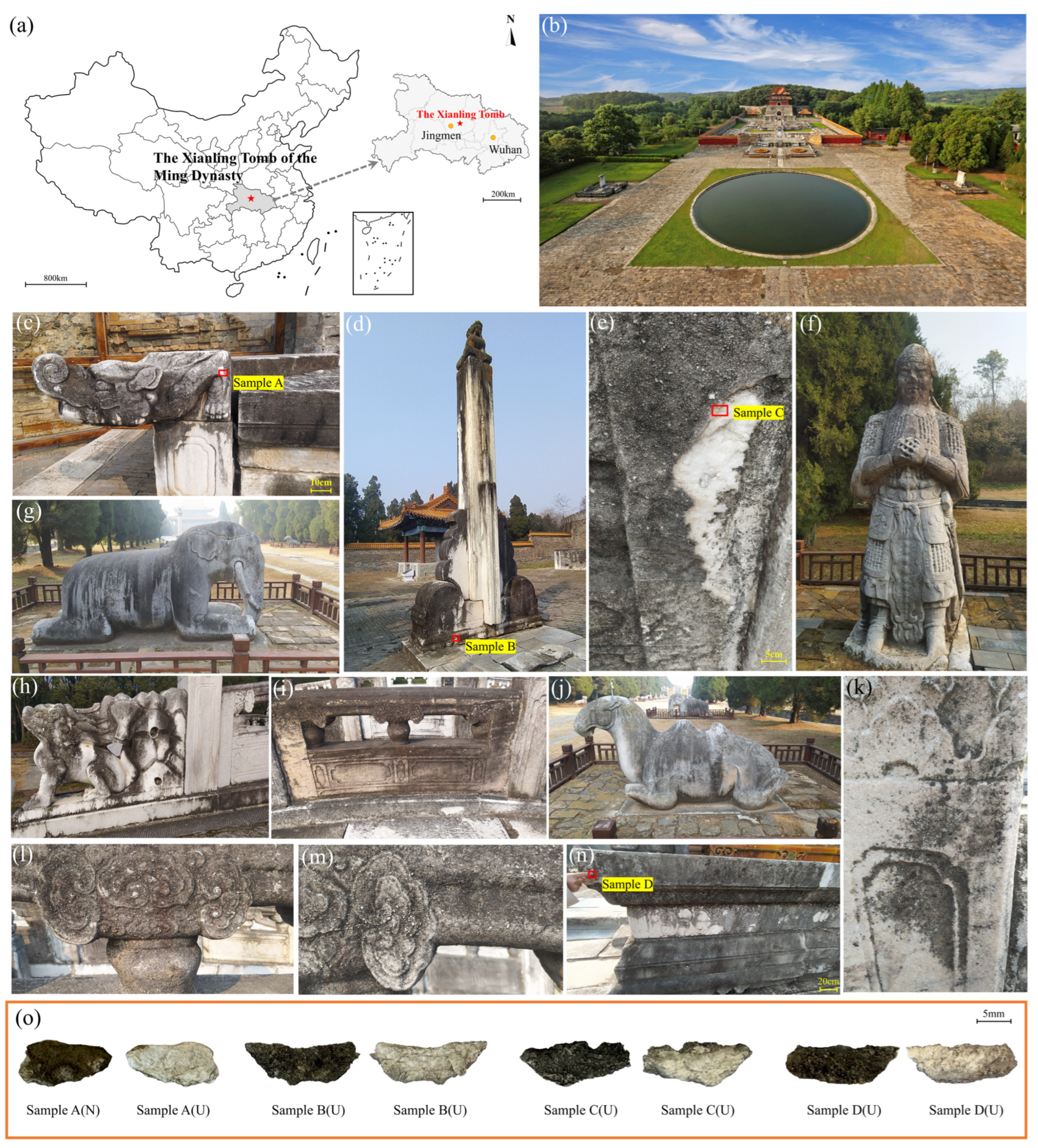

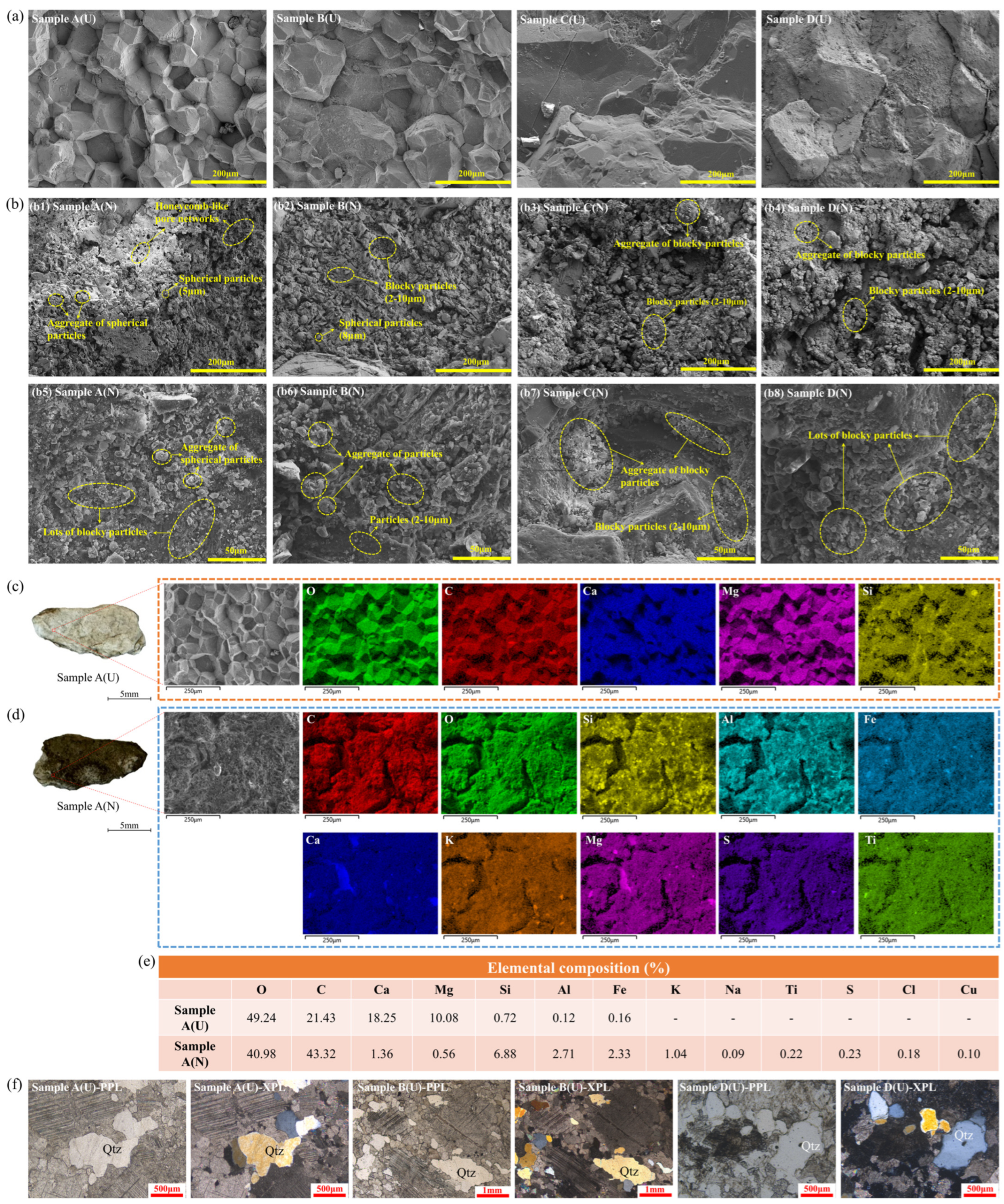
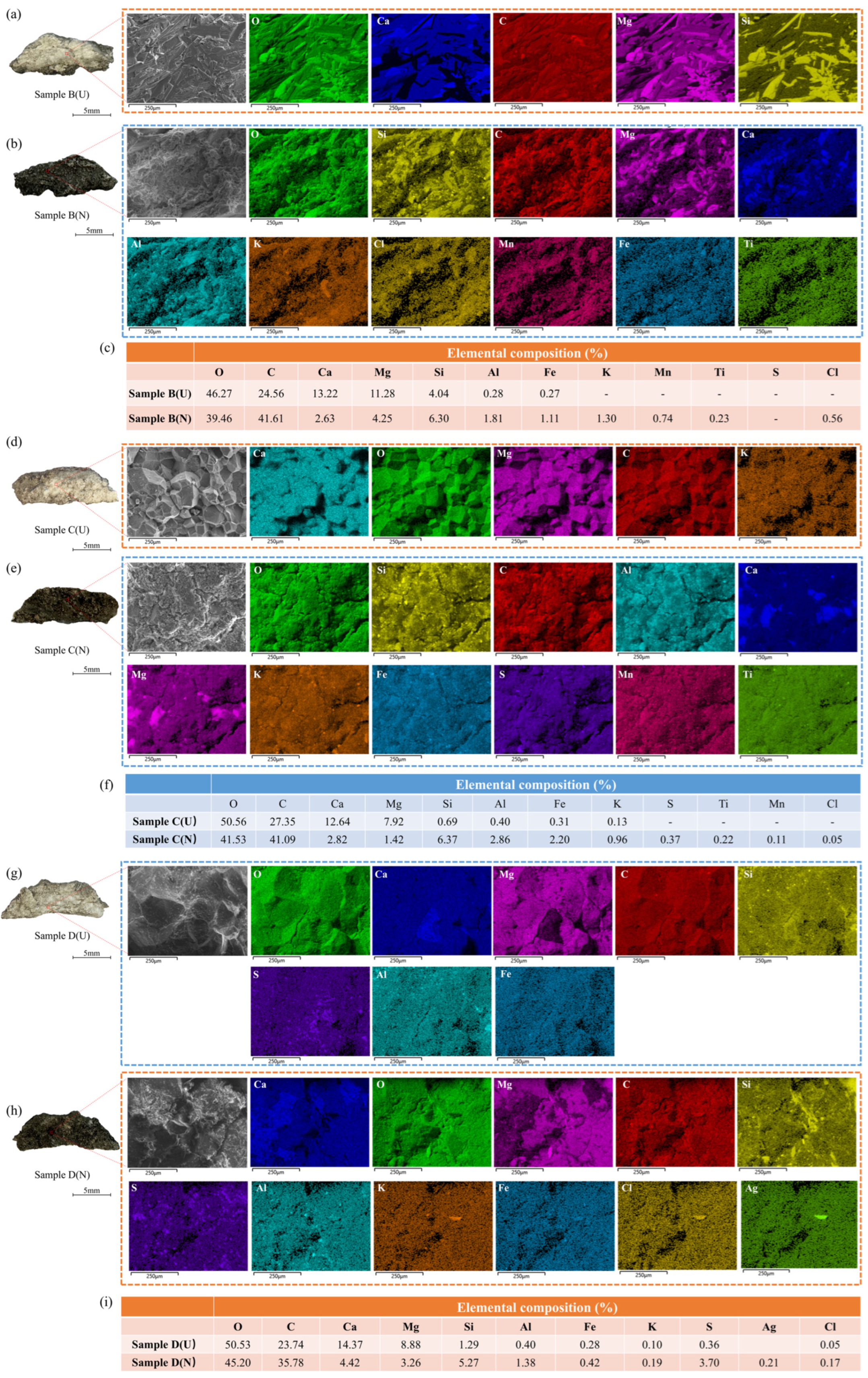
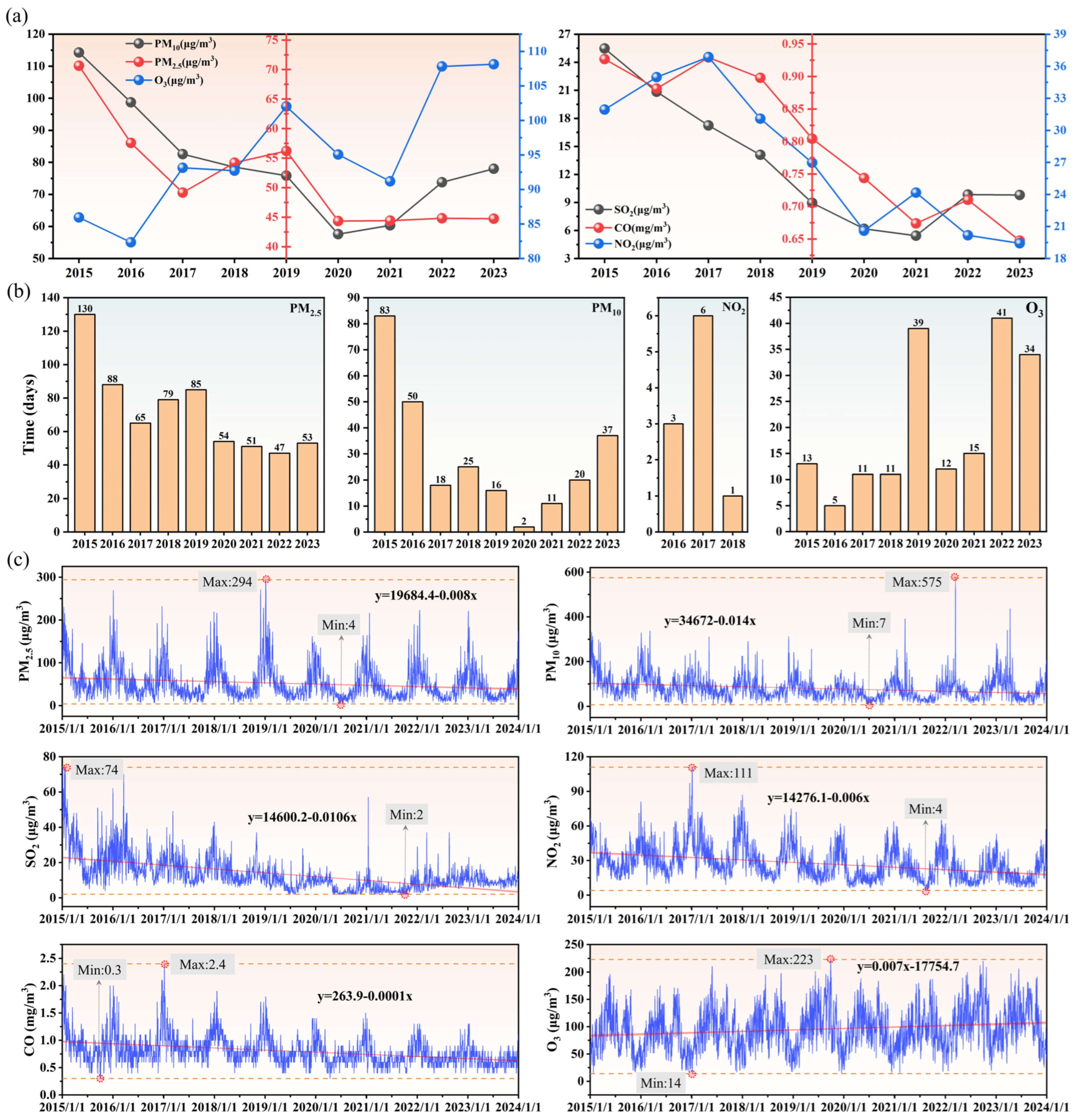


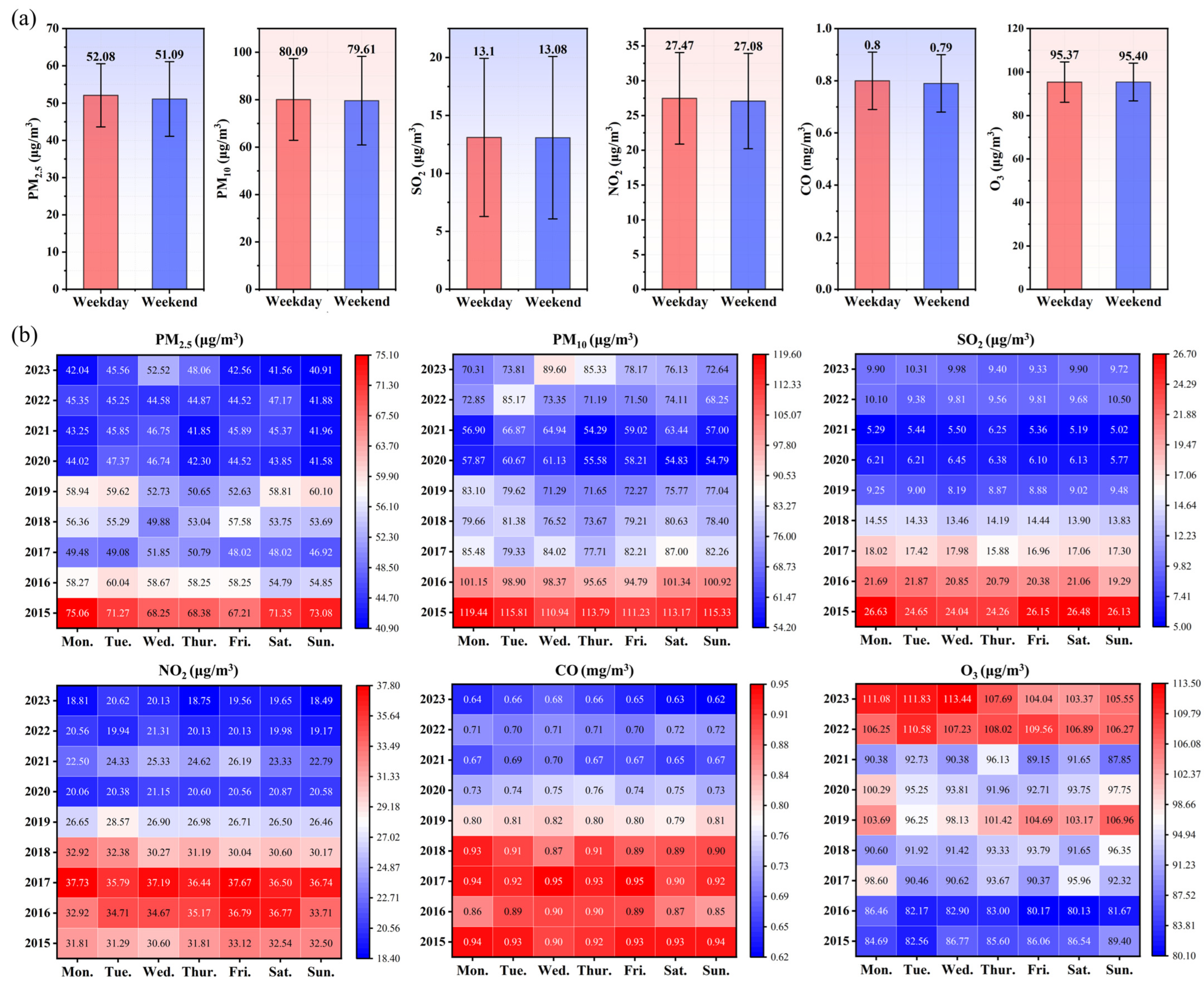
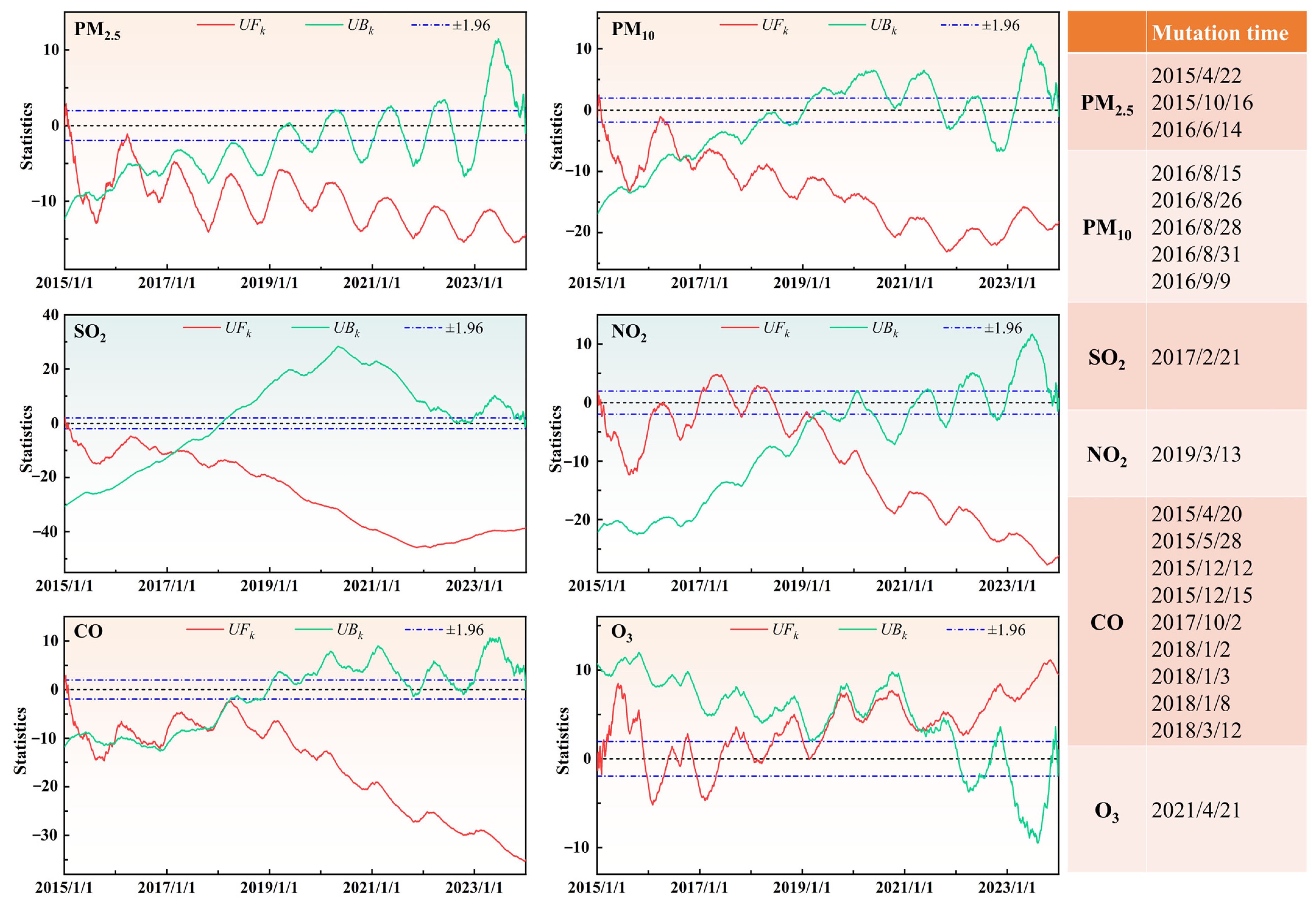

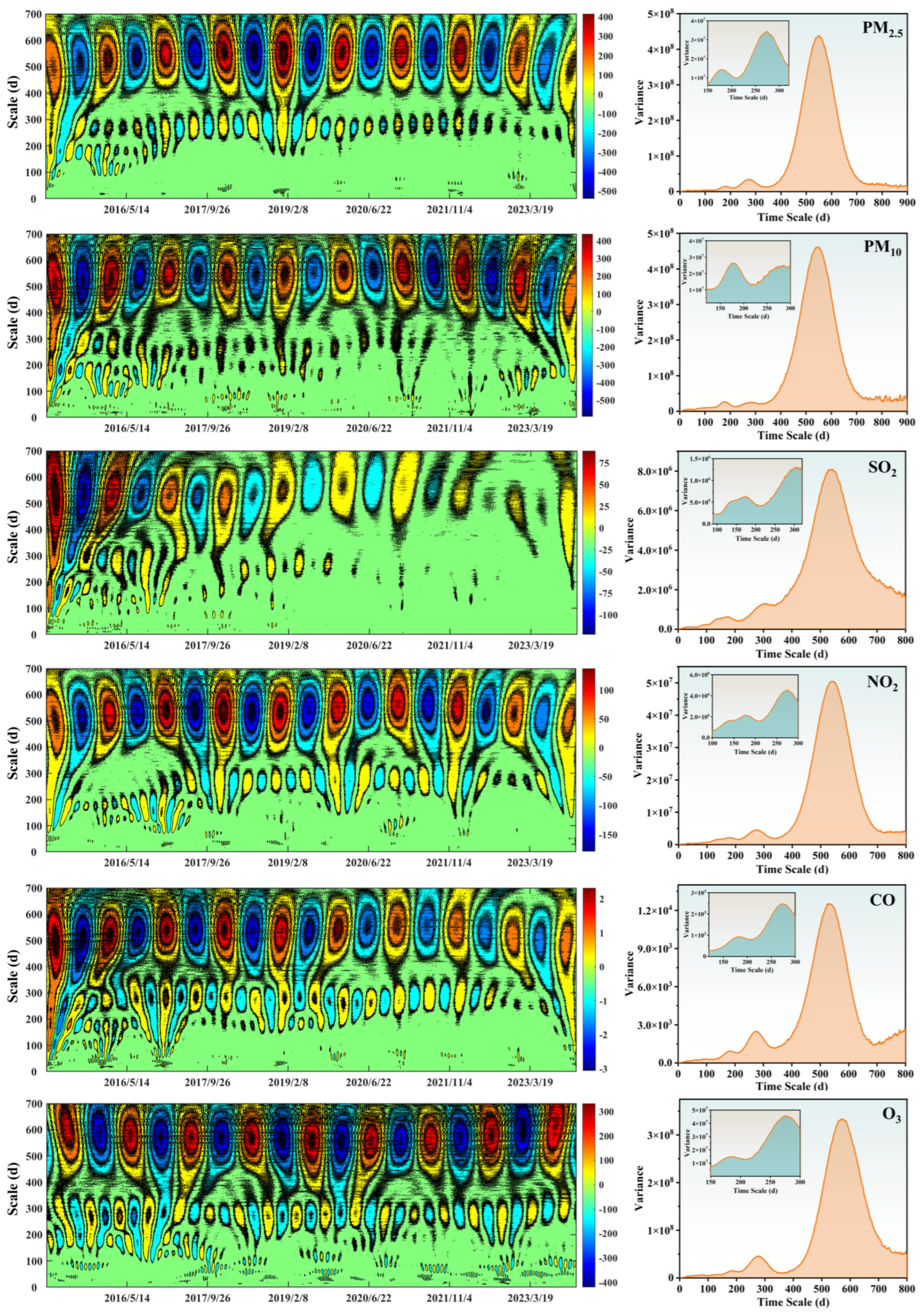
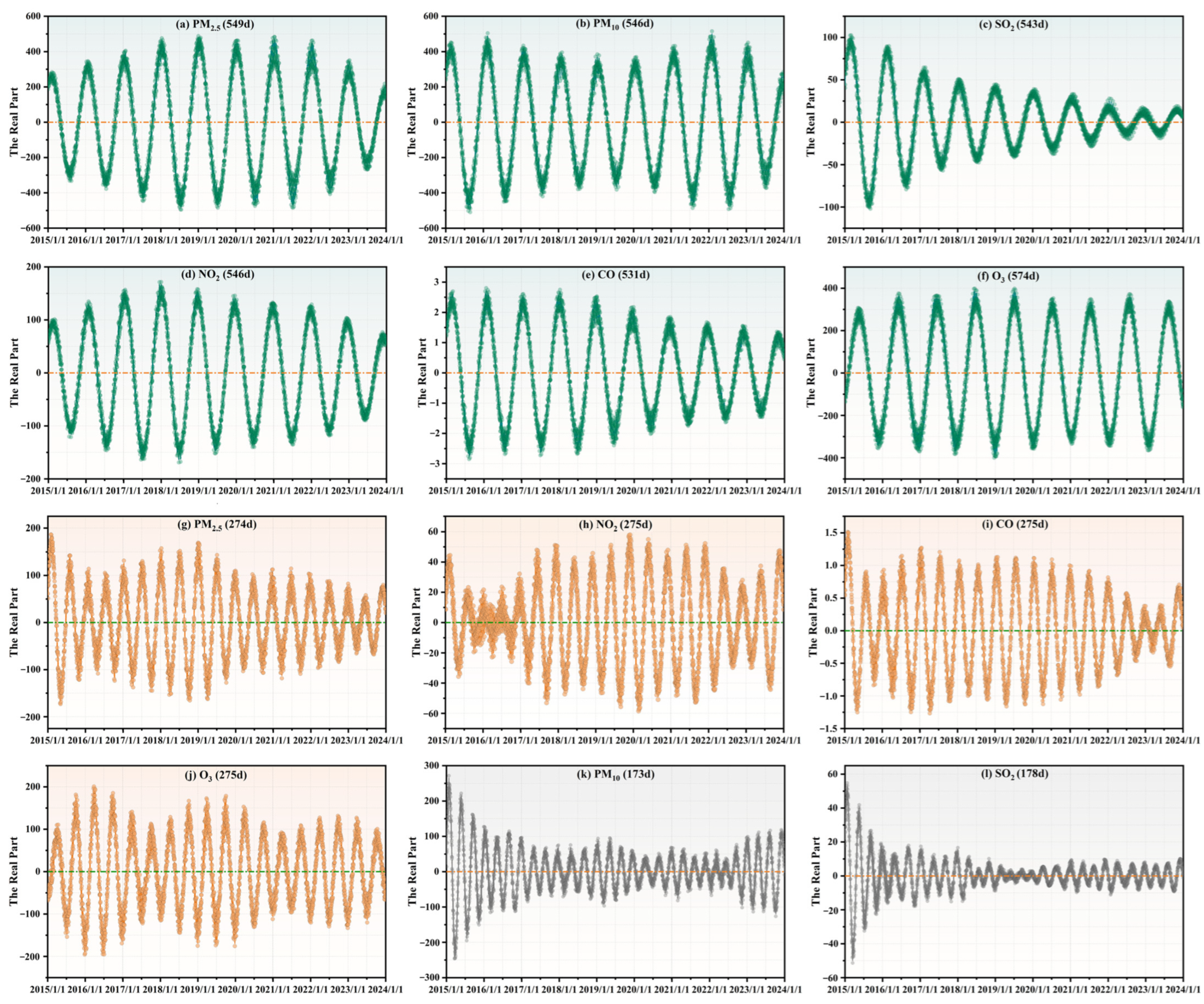
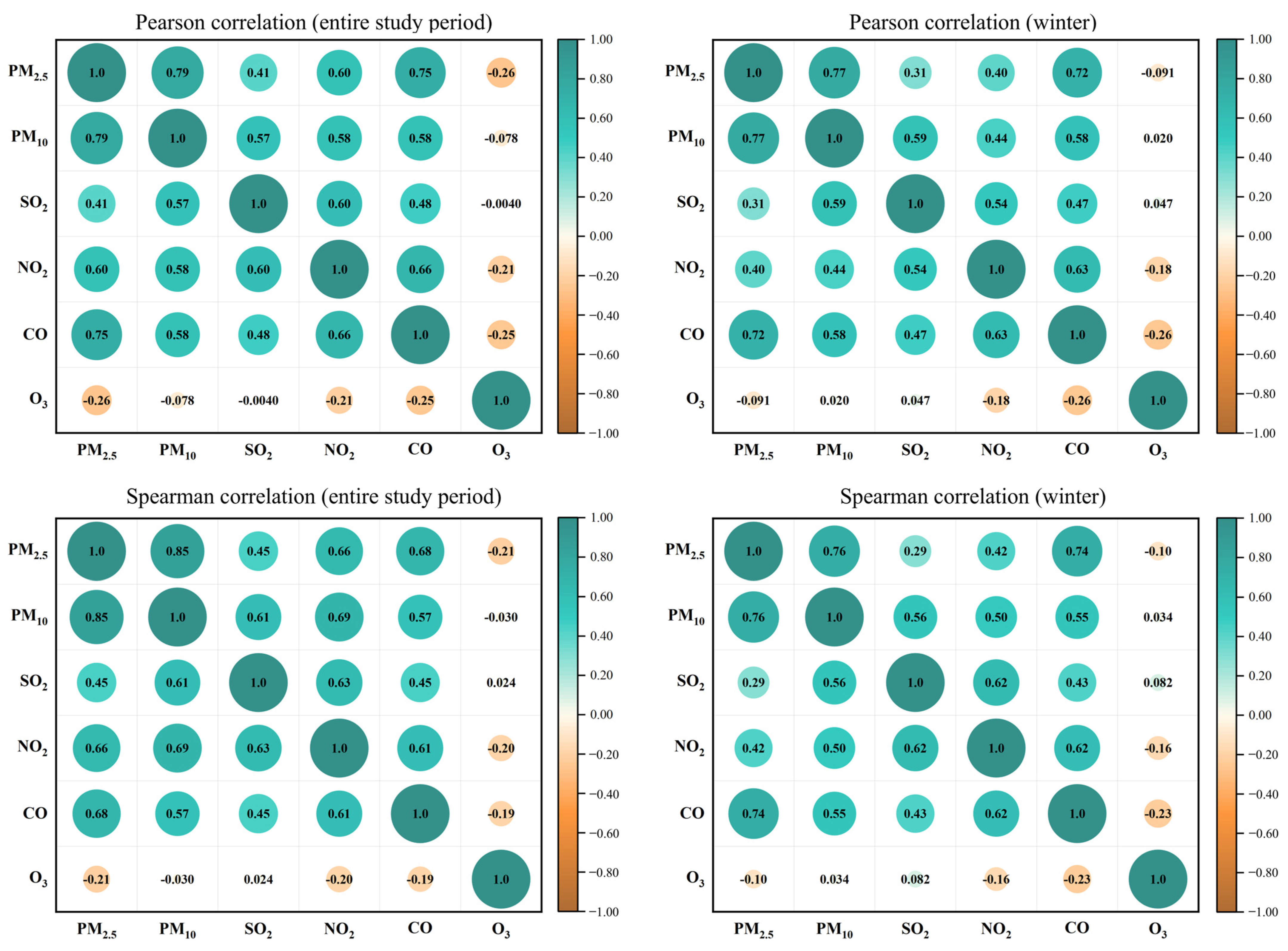


| Variables | Entire Study Period | Winter | ||
|---|---|---|---|---|
| AWC | PASC (%) | AWC | PASC (%) | |
| PM2.5-PM10 | 0.7170 | 59.90% | 0.6933 | 54.52% |
| PM2.5-SO2 | 0.4068 | 15.55% | 0.3522 | 8.37% |
| PM2.5-NO2 | 0.5165 | 29.48% | 0.4792 | 19.08% |
| PM2.5-CO | 0.5950 | 43.78% | 0.6667 | 50.42% |
| PM2.5-O3 | 0.5062 | 26.15% | 0.4042 | 9.26% |
| PM10-SO2 | 0.4978 | 25.56% | 0.4740 | 17.63% |
| PM10-NO2 | 0.5292 | 31.29% | 0.4624 | 19.43% |
| PM10-CO | 0.5361 | 27.88% | 0.5159 | 28.23% |
| PM10-O3 | 0.4491 | 23.58% | 0.3676 | 8.64% |
| SO2-NO2 | 0.5176 | 29.91% | 0.4467 | 20.92% |
| SO2-CO | 0.4341 | 17.69% | 0.3451 | 6.45% |
| SO2-O3 | 0.4326 | 20.41% | 0.3907 | 12.32% |
| NO2-CO | 0.5371 | 29.46% | 0.5132 | 26.63% |
| NO2-O3 | 0.4858 | 23.15% | 0.4171 | 15.56% |
| CO-O3 | 0.4206 | 20.61% | 0.3416 | 9.49% |
Disclaimer/Publisher’s Note: The statements, opinions and data contained in all publications are solely those of the individual author(s) and contributor(s) and not of MDPI and/or the editor(s). MDPI and/or the editor(s) disclaim responsibility for any injury to people or property resulting from any ideas, methods, instructions or products referred to in the content. |
© 2025 by the authors. Licensee MDPI, Basel, Switzerland. This article is an open access article distributed under the terms and conditions of the Creative Commons Attribution (CC BY) license (https://creativecommons.org/licenses/by/4.0/).
Share and Cite
Yi, Y.; Wang, C.; Li, K.; Jia, X.; Wang, C.; Wang, Y. Revealing Black Stains on the Surface of Stone Artifacts from Material Properties to Environmental Sustainability: The Case of Xianling Tomb, China. Sustainability 2025, 17, 3422. https://doi.org/10.3390/su17083422
Yi Y, Wang C, Li K, Jia X, Wang C, Wang Y. Revealing Black Stains on the Surface of Stone Artifacts from Material Properties to Environmental Sustainability: The Case of Xianling Tomb, China. Sustainability. 2025; 17(8):3422. https://doi.org/10.3390/su17083422
Chicago/Turabian StyleYi, Yu, Chengaonan Wang, Kai Li, Xianshi Jia, Cong Wang, and Yansong Wang. 2025. "Revealing Black Stains on the Surface of Stone Artifacts from Material Properties to Environmental Sustainability: The Case of Xianling Tomb, China" Sustainability 17, no. 8: 3422. https://doi.org/10.3390/su17083422
APA StyleYi, Y., Wang, C., Li, K., Jia, X., Wang, C., & Wang, Y. (2025). Revealing Black Stains on the Surface of Stone Artifacts from Material Properties to Environmental Sustainability: The Case of Xianling Tomb, China. Sustainability, 17(8), 3422. https://doi.org/10.3390/su17083422










